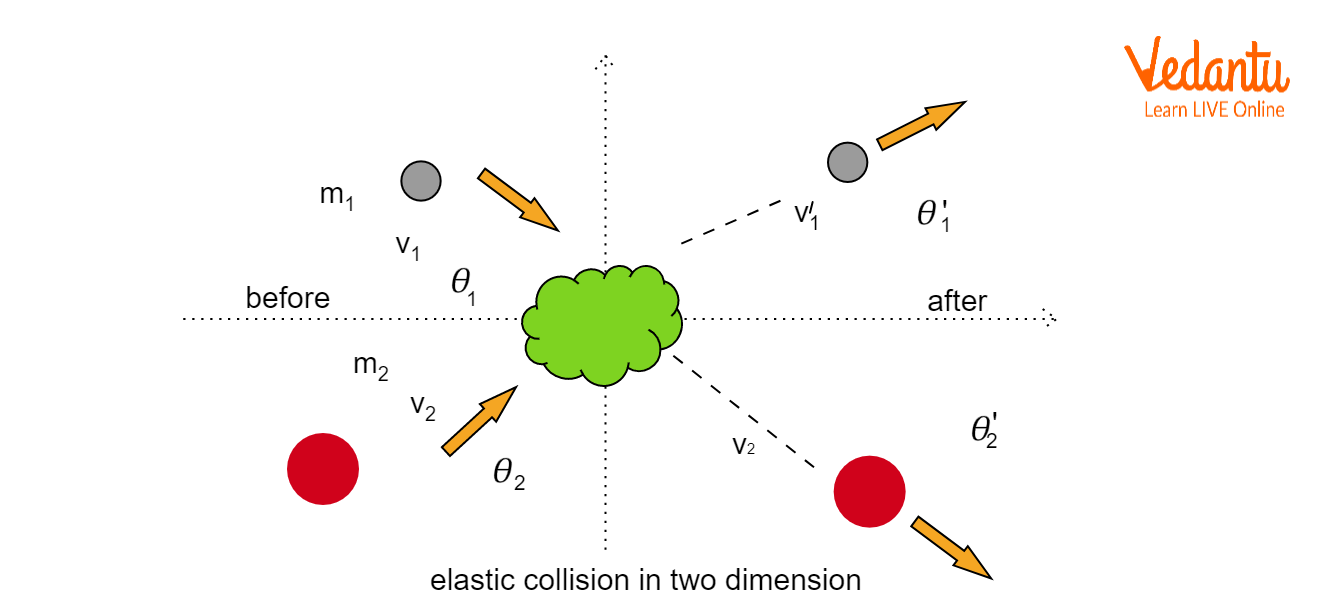




Derivation and Laws of Elastic Collision in Two Dimensions (with Diagrams)
Elastic collision in two dimensions is the study of collisions where two objects interact in a plane, conserving both linear momentum and kinetic energy in both the x and y directions. Typical examples include billiard ball games or particle collisions in physics labs. Mastering this concept is essential for JEE Main as it blends clear vector logic with fundamental conservation laws.
Most daily encounters with collisions are either one-dimensional (like cars bumping end-to-end) or two-dimensional, as seen in games or molecular physics. Unlike inelastic collisions, here, no kinetic energy is lost; direction and speed both matter, making vector analysis crucial.
Key Laws and Equations Governing Elastic Collision in Two Dimensions
For 2D elastic collisions, two physical laws are always conserved: conservation of linear momentum and conservation of kinetic energy. They serve as the foundation for all derivations and numericals.
- Momentum conservation (x-direction): m₁u₁ₓ + m₂u₂ₓ = m₁v₁ₓ + m₂v₂ₓ
- Momentum conservation (y-direction): m₁u₁ᵧ + m₂u₂ᵧ = m₁v₁ᵧ + m₂v₂ᵧ
- Kinetic energy conservation: (½)m₁u₁2 + (½)m₂u₂2 = (½)m₁v₁2 + (½)m₂v₂2
Here, m₁, m₂ are the masses; u₁, u₂ are initial speeds; v₁, v₂ are final speeds; subscripts x and y refer to respective components.
Step-by-Step Derivation of 2D Elastic Collision Equations
Let’s consider two objects of masses m₁ and m₂. Assume m₁ is moving with initial velocity u₁ at an angle θ₁ and m₂ is at rest for clarity, a frequent JEE scenario.

After collision, let the velocities be v₁ (angle φ₁) and v₂ (angle φ₂) for m₁ and m₂, respectively. Conservation equations become:
- x-component: m₁u₁ = m₁v₁cosφ₁ + m₂v₂cosφ₂
- y-component: 0 = m₁v₁sinφ₁ – m₂v₂sinφ₂
- Kinetic energy: m₁u₁2 = m₁v₁2 + m₂v₂2 (if m₂ initially at rest)
Solving these simultaneously gives the final velocities and angles. For numerical application, values are substituted, and directions are resolved into x and y using trigonometry.

If both masses are equal and one is at rest, the scattered balls after collision move at right angles (90°), a classic result often asked in exams. Understanding vector forms and angles is the key.
Diagrammatic Explanation and Application in Numericals
The typical setup for elastic collision in two dimensions involves determining the final velocities and angles using vector diagrams. Arrows before and after collision show directions; components are broken down along the x and y axes for calculation clarity.
For equations and examples requiring angles, always use cosine/sine for splitting vectors and verify directions. In oblique collisions (not head-on), this ensures you compute the correct momentum balance.
- Momentum must be conserved along each axis independently
- Kinetic energy conservation applies only to perfectly elastic collision
- Always draw a clear diagram indicating angle conventions
- Check sign conventions for components
Further strengthen your basics on momentum and work and energy for rapid problem-solving in 2D collisions.
Special Cases, Contrasts, and A Solved Example
Common special cases for 2D elastic collisions in JEE are:
- Both masses equal (m₁ = m₂), one at rest: scattering at 90° after collision.
- Oblique collision: Approach and separation angles are related by conservation laws.
- Perfectly head-on (1D) collision: Both axes reduce to a single equation.
- Glancing collisions: Check all angle and sign conventions.
| Type | Momentum | Kinetic Energy |
|---|---|---|
| Elastic | Conserved | Conserved |
| Inelastic | Conserved | Not Conserved |
Solved Example: Ball A (1 kg) moves at 4 m/s towards stationary ball B (1 kg) in 2D. After elastic collision, if A moves off at 60° with 2 m/s, find ball B’s speed and direction.
- x: 4 = 2 × 0.5 + vBcosθ → 4 = 1 + vBcosθ
- y: 0 = 2 × 0.866 – vBsinθ → vBsinθ = 1.732
- Solve for vB using vB2 = (3)2 + (1.732)2 → vB = 3.464 m/s
Thus, ball B moves at 3.46 m/s at an angle with cosθ = 3/3.464.
Common pitfalls: ignore friction (unless specified), always check that energy and both components of momentum are balanced, and never mix up sign conventions for vectors.
For more solved questions spanning multiple cases, refer to collision types with solutions and oblique collision derivations.
Elastic Collision in Two Dimensions vs Inelastic Collision
A major exam focus is differentiating elastic collision from inelastic collision in two dimensions. Remember, momentum is always conserved, but only in elastic scenarios is kinetic energy conserved.
- In inelastic collisions, bodies may stick together or deform; use only the momentum conservation equations.
- Elastic collisions retain both total momentum and kinetic energy.
- Perfectly inelastic: final velocities align, and some energy is lost as heat/sound/shape change.
- The coefficient of restitution (e) helps mathematically distinguish the case (e=1 for elastic, 0<e<1 for inelastic).
Deepen your understanding using these resources: momentum conservation theory, elastic collision 1D cases, and coefficient of restitution details.
Typical JEE Practice and Final Tips
To master elastic collision in two dimensions for JEE, practice with different initial directions, varying masses, and apply stepwise conservation. Focus on thorough vector resolution and double check for hidden energy loss in problems that seem elastic.
- Identify axes clearly in diagrams for each question
- Use stepwise component analysis for every collision
- In real-life, few collisions are truly elastic—use the model unless energy loss is given
- Practise with JEE Main physics practice questions for best recall
Vedantu content is always developed by IIT alumni and exam experts, so trust the methods outlined here. For core principles, revise from Laws of Motion, system of particles, and link in center of mass concepts for shortcuts and deeper insights.
With disciplined practice, strong command on vector resolution, and careful attention to conservation laws, you’ll consistently excel in both numericals and theoretical questions covering elastic collision in two dimensions.
FAQs on Elastic Collision in Two Dimensions: Concepts, Laws, Derivation & Examples
1. What is an elastic collision in two dimensions?
An elastic collision in two dimensions is a type of collision where both linear momentum and kinetic energy are conserved along both the x and y axes.
Key points include:
- Both momentum and kinetic energy remain constant before and after collision.
- Typical examples: billiard ball collisions, atomic or molecular interactions.
- Requires resolving velocities and forces into two perpendicular directions (usually x and y).
2. What are the two equations for a two-dimensional elastic collision?
In a two-dimensional elastic collision, the key formulas are:
- Conservation of Momentum (for both axes):
- In x-direction: m1u1x + m2u2x = m1v1x + m2v2x
- In y-direction: m1u1y + m2u2y = m1v1y + m2v2y
- Conservation of Kinetic Energy:
1/2 m1u12 + 1/2 m2u22 = 1/2 m1v12 + 1/2 m2v22
3. How do you derive the equations for elastic collision in two dimensions?
Deriving equations for 2D elastic collisions involves applying conservation laws along each axis.
Steps:
- Draw a diagram showing both bodies with their initial velocities and angles.
- Apply conservation of momentum separately for x and y axes.
- Apply conservation of kinetic energy for total energy.
- Solve the system of equations for final velocities and directions using trigonometric resolution.
4. What laws govern a two-dimensional elastic collision?
The laws that govern a two-dimensional elastic collision are:
- Law of Conservation of Linear Momentum (applied independently along x and y axes)
- Law of Conservation of Kinetic Energy (total energy conserved)
5. What is the difference between an elastic and inelastic collision in two dimensions?
Elastic collisions in 2D conserve both momentum and kinetic energy, while inelastic collisions conserve only momentum, not kinetic energy.
Key differences:
- Elastic: Both momentum and kinetic energy conserved
- Inelastic: Momentum conserved, kinetic energy lost (partly or completely)
- Perfectly inelastic: Colliding bodies may stick together
6. Can you give examples of a 2D elastic collision?
Common real-life and exam examples include:
- Billiard balls colliding at an angle on a pool table
- Atoms or molecules bouncing off each other in a gas
- Carom coins striking each other
7. What is an inelastic collision in 1d and 2d?
An inelastic collision is when only momentum is conserved but kinetic energy is not.
Details:
- In 1D: Objects stick together or deform; analyzed along one line.
- In 2D: Objects may change directions; analyzed along two axes; some kinetic energy transforms into heat or sound.
8. Why do we consider axes (x, y) separately in 2D collisions?
In 2D collisions, momentum must be conserved independently along the x and y axes because forces act and velocities change in different directions.
Advantages:
- Makes calculations manageable using vector components
- Ensures application of Newton's Laws and conservation principles for each direction
9. Does kinetic energy always remain constant in real-life 2D collisions?
In practice, kinetic energy is rarely perfectly conserved in real-life 2D collisions because some energy is lost as heat, sound, or deformation.
However:
- Elastic collisions (ideal) conserve kinetic energy
- Real collisions are often nearly elastic, especially with hard, smooth objects
10. What is the role of the coefficient of restitution in 2D collisions?
The coefficient of restitution (e) measures how 'bouncy' a collision is, indicating the ratio of relative speeds after and before collision.
Key points:
- e = 1 for perfectly elastic collisions (no kinetic energy loss)
- e < 1 for inelastic collisions (kinetic energy lost)
- Used especially if objects collide at angles or in oblique scenarios
11. How do angles after collision relate to masses and velocities?
The angles at which objects move after a 2D elastic collision depend on their masses and velocities.
Summary:
- Angles can be calculated by resolving final velocities into x and y components
- For equal masses, often move at right angles (90°) if one is initially at rest
- Requires simultaneous use of conservation equations and trigonometry
12. Are collisions actually perfectly elastic in nature?
Perfectly elastic collisions are idealized and rare in nature; most real-world collisions are nearly elastic or inelastic.
Real examples:
- Atomic and molecular collisions (in gases) can closely approach perfect elasticity.
- Everyday objects (balls, cars) experience some energy loss as heat or sound.


































